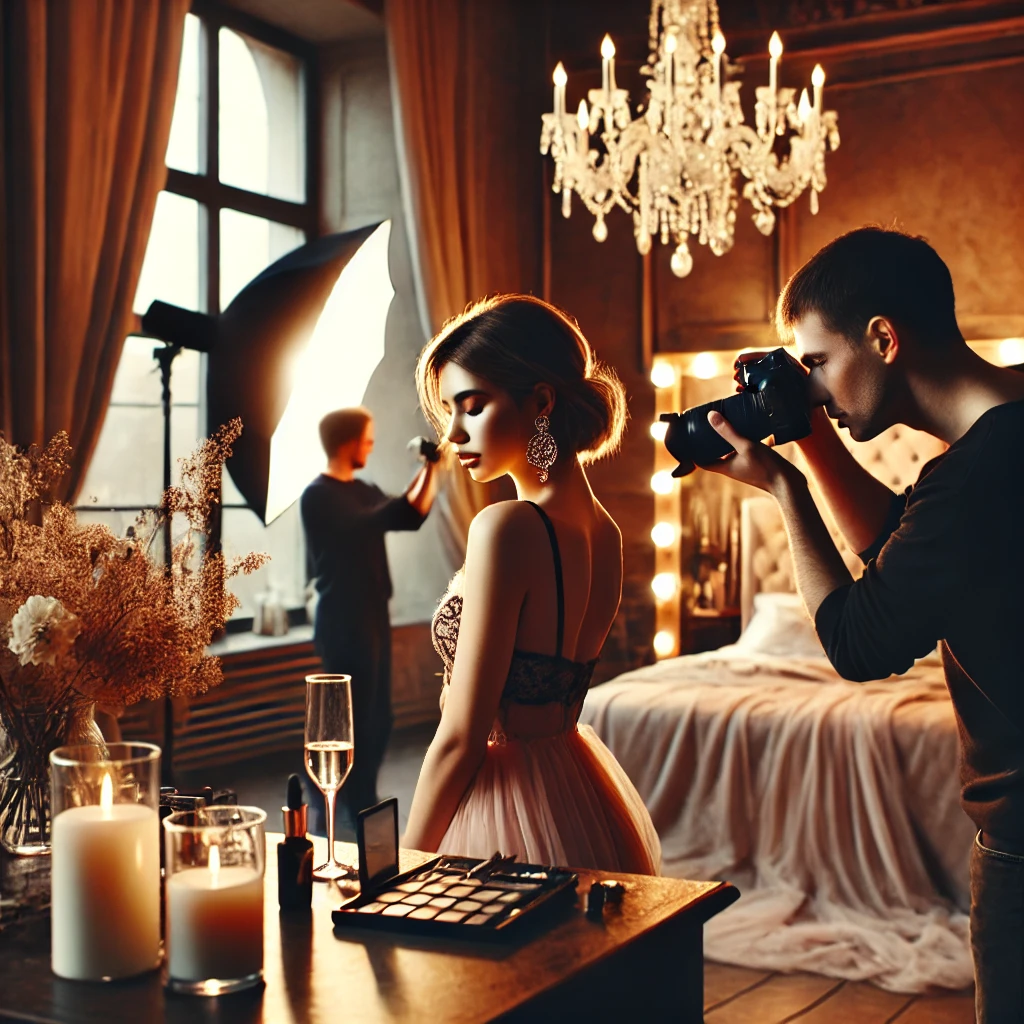Boudoir photography is an intimate and artistic form of portraiture that celebrates confidence, beauty, and self-expression. A bold & boudoir photoshoot is more than just taking pictures—it’s about creating an empowering experience that showcases the subject’s personality and style. In this guide, we’ll take you behind the scenes of a boudoir session, covering everything from planning and preparation to lighting, posing, and post-processing.
1. Planning the Boudoir Photoshoot
Understanding the Client’s Vision
- Every boudoir session starts with a conversation.
- Discuss expectations, personal style, and comfort levels.
- Determine the purpose of the shoot (personal empowerment, a gift, portfolio building, etc.).
Choosing the Right Location
- A boudoir session can take place in a studio, luxury hotel, or the client’s home.
- The setting should complement the theme, whether it’s soft and romantic or edgy and bold.
Wardrobe Selection
- Encourage outfits that make the client feel confident and beautiful.
- Options include lace lingerie, bodysuits, oversized shirts, or even elegant robes.
- Neutral tones create a timeless look, while bold colors add drama.
Makeup and Hairstyling
- Professional makeup and hairstyling enhance the final results.
- Soft curls, voluminous waves, or sleek styles add to the mood of the shoot.
- Makeup should complement the lighting setup and wardrobe.
2. Setting Up the Perfect Boudoir Scene
Lighting Techniques for Boudoir Photography
- Natural Light: Soft window light creates a dreamy, organic look.
- Artificial Light: Studio lighting with softboxes or ring lights enhances definition.
- Moody Lighting: Using shadows and highlights to create depth and intrigue.
Background and Props
- Minimalistic backdrops keep the focus on the subject.
- Velvet chairs, satin sheets, and vintage mirrors add elegance.
- Candles and fairy lights contribute to a warm, intimate ambiance.
3. Directing and Posing for Confidence
Making the Client Comfortable
- Establish trust by engaging in relaxed conversation.
- Offer gentle direction and reassurance throughout the shoot.
- Encourage natural movements and breathing techniques to ease nervousness.
Flattering Poses for Boudoir Photography
- Lying Down: Creates elegant and elongated lines.
- Arched Back Poses: Accentuates curves and posture.
- Seated Elegance: Legs crossed or tucked under add sophistication.
- Against the Wall: Creates a powerful, confident stance.
4. Capturing Emotion and Expression
Focusing on Details
- Close-up shots of hands, lips, and fabric textures create artistic compositions.
- Capturing the moment a subject adjusts a strap or plays with their hair adds authenticity.
Using Movement to Add Drama
- Ask the subject to sway, twirl, or shift weight to create natural flow.
- Hair flips, draped fabrics, and strategic light movement enhance the cinematic feel.
5. Post-Processing and Final Touches
Retouching While Maintaining Authenticity
- Focus on skin smoothing without losing texture.
- Adjust lighting and contrast to enhance mood.
- Keep color grading consistent for a polished aesthetic.
Delivering the Final Images
- Offer a curated selection of retouched images in an online gallery.
- Provide both color and black & white versions for variety.
- Ensure secure and private delivery methods for client confidentiality.
Conclusion
A bold & boudoir photoshoot is a transformative experience that highlights confidence and beauty. By understanding the process from planning to final delivery, photographers can create stunning imagery that empowers their clients. Whether you’re new to boudoir photography or looking to refine your approach, these insights will help you craft unforgettable sessions.

Mobile Photography Hacks: Candid Moments with Your Phone

Professional Model & Portfolio Photoshoots: Show Your Best Work
-

Street Photography Tips, Effects & Poses – Complete Guide
-

Leica Q2 for Photography: Why It’s Loved by Photographers
Mobile Photography Hacks: Candid Moments with Your Phone
Discover high-impact mobile photography hacks to capture genuine, gorgeous candid moments with your phone. Learn practical tips, composition secrets, and pro techniques to turn everyday scenes into stunning visual stories. Introduction: The New Age of Mobile Photography Photography has evolved beyond heavy cameras, technical jargon, and expensive equipment. Today, the power to capture extraordinary moments
Professional Model & Portfolio Photoshoots: Show Your Best Work
” Discover how to plan, style, and execute stunning portfolio photoshoots that showcase your skills, personality, and versatility. This comprehensive guide covers professional tips, posing ideas, gear suggestions, and industry insights for models and photographers.” Introduction – Why Portfolio Photoshoots Are the Cornerstone of a Photographer’s Career A well-crafted portfolio photoshoot is more than a
Street Photography Tips, Effects & Poses – Complete Guide
Discover the ultimate guide to Street Photography with expert tips, creative effects, and dynamic poses. Learn how to capture authentic urban moments, master composition, and tell powerful visual stories through your lens. Article Outline 1. Introduction to Street Photography Street Photography is more than just taking pictures of people in public spaces — it’s about
Leica Q2 for Photography: Why It’s Loved by Photographers
Introduction: The Cult Status of the Leica Q2 The Leica Q2 is not just a camera—it’s a statement. Combining the heritage of German precision engineering with modern digital excellence, it holds a special place in the hearts of professional and passionate photographers alike. With its full-frame sensor, prime Summilux lens, and minimalist design, the Q2
Top Cameras Under ₹1 Lakh for Freelance Photography
Freelance photography is no longer a niche—it’s a booming creative profession that demands not only vision and hustle but also the right gear. Your camera isn’t just a tool; it’s your storytelling partner. If you’re a freelance photographer aiming to balance performance, versatility, and budget, investing in a cameras under ₹1 lakh can offer the
Top Features of Nikon D850 That Make It Ideal for Photoshoots
Explore the top features of the Nikon D850 that make it a powerhouse for photoshoots. From exceptional resolution to dynamic range, this detailed Nikon D850 guide is built for professional and aspiring photographers. 1. Introduction When Nikon launched the D850, it quickly earned a reputation as a flagship DSLR that redefined what photographers could expect






